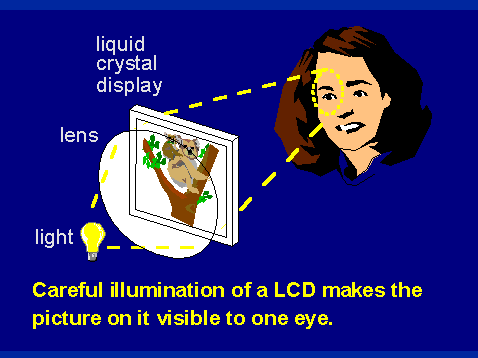| © CMG Lee • Dec2003 | |||||||||||||||||||||||||||||||||||||||||||
| Home | Basic 3D | Projection | Holographic | Optical addressing | Flat panel | Survey | Accommodation | Autostereo | Perspective | Principles | Simulation | Cam Display | References | ||||||||||||||||||||||||||||||
|---|---|---|---|---|---|---|---|---|---|---|---|---|---|---|---|---|---|---|---|---|---|---|---|---|---|---|---|---|---|---|---|---|---|---|---|---|---|---|---|---|---|---|---|
We are working on new ways of televising a real three dimensional image, like that of a hologram.
The most popular way of televising a supposedly three dimensional image
is to make the user wear a pair of spectacles incorporating liquid crystal
shutters. The picture on the display alternates between a left-eye view
and a right-eye view, and if this is synchronised with the spectacle shutters
at a sufficient rate the viewer sees a flicker free stereo image. But spectacles
get lost, and stereo images aren’t truly three dimensional, for example
the image doesn’t change as the viewer moves about the display.
| We eliminate the spectacles by making a display
with a field of view which can be restricted to one or other of the viewer’s
eyes. The simplest way to do this is to illuminate a liquid crystal display
with a lens and a spotlight behind the lens.
An eye will see the image on a liquid crystal display only if it is
illuminated with rays of light which all converge to the eye, and this
will happen only if the image of the spotlight formed by the lens falls
on the eye. A second light can be added in order to illuminate the picture
to the other eye, and if the two are lit alternately, it is possible to
produce a stereo 3D image in the same way as with spectacles.
Of course if the viewer’s head moves, they will no longer be able to see the image, but we can add other lights which switch on when other views of the 3D image are on display, and if the whole is repeated quickly enough to avoid flicker the viewer will be able to move all round the 3D image. It can be shown that with enough views, this constitutes a three dimensional image which is like a hologram in every respect except that the image has limited resolution. |

|
| Copyright CMG Lee & ARL Travis, Photonics and Sensors Group, Cambridge University Engineering Department |